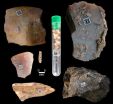(Press-News.org) Australian scientists using new image and cell technologies have for the first time caught malaria parasites in the act of invading red blood cells. The researchers, from the Walter and Eliza Hall Institute in Melbourne, Australia, and the University of Technology, Sydney (UTS), achieved this long-held aim using a combination of electron, light and super resolution microscopy, a technology platform new to Australia.
The detailed look at what occurs as the parasite burrows through the walls of red blood cells provides new insights into the molecular and cellular events that drive cell invasion and may pave the way for developing new treatments for malaria. Institute researchers Dr Jake Baum, Mr David Riglar, Dr Dave Richard and colleagues from the institute's Infection and Immunity division led the research with colleagues from the i3 institute at UTS.
Dr Baum said the real breakthrough for the research team had been the ability to capture high-resolution images of the parasite at each and every stage of invasion, and to do so reliably and repeatedly. Their findings are published in today's issue of the journal Cell Host & Microbe.
"It is the first time we've been able to actually visualise this process in all its molecular glory, combining new advances developed at the institute for isolating viable parasites with innovative imaging technologies," Dr Baum said.
"Super resolution microscopy has opened up a new realm of understanding into how malaria parasites actually invade the human red blood cell. Whilst we have observed this miniature parasite drive its way into the cell before, the beauty of the new imaging technology is that it provides a quantum leap in the amount of detail we can see, revealing key molecular and cellular events required for each stage of the invasion process."
The imaging technology, called OMX 3D SIM super resolution microscopy, is a powerful new 3D tool that captures cellular processes unfolding at nanometer scales. The team worked closely with Associate Professor Cynthia Whitchurch and Dr Lynne Turnbull from the i3 institute at UTS to capture these images.
"This is just the beginning of an exciting new era of discoveries enabled by this technology that will lead to a better understanding of how microbes such as malaria, bacteria and viruses cause infectious disease," Associate Professor Whitchurch said.
Dr Baum said the methodology would be integral to the development of new malaria drugs and vaccines. "If, for example, you wanted to test a particular drug or vaccine, or investigate how a particular human antibody works to protect you from malaria, this imaging approach now gives us a window to see the actual effects that each reagent or antibody has on the precise steps of invasion," he said.
Malaria is caused by the Plasmodium parasite, which is transmitted by the bite of infected mosquitoes. Each year more than 400 million people contract malaria, and as many as a million, mostly children, die.
"Historically it has been very difficult to both isolate live and viable parasites for infection of red blood cells and to employ imaging technologies sensitive enough to capture snapshots of the invasion process with these parasites, which are only one micron (one millionth of a metre) in diameter," Dr Baum said.
He said one of the most interesting discoveries the imaging approach revealed was that once the parasite has attached to the red blood cell and formed a tight bond with the cell, a master switch for invasion is initiated and invasion will continue unabated without any further checkpoints.
"The parasite actually inserts its own window into the cell, which it then opens and uses to walk into the cell, which is quite extraordinary," Dr Baum said. "Visually tracking the invasion of Plasmodium falciparum into a red blood cell is something I've been aiming at ever since I began at the Walter and Eliza Hall Institute in 2003; it's really thrilling to have reached that goal. This technology enables us to look at individual proteins that we always knew were involved in invasion, but we never knew what they did or where they were, and that, we believe, is a real leap for malaria researchers worldwide."
INFORMATION:
This work was supported by the National Health and Medical Research Council, The University of Melbourne, Canadian Institutes of Health, the University of Technology, Sydney, and the Australian Research Council.
Malaria parasite caught red-handed invading blood cells
2011-01-20
ELSE PRESS RELEASES FROM THIS DATE:
Fears of Ontario pharmacy shortage after slashed generic drug prices unfounded: UBC research
2011-01-20
A University of British Columbia study shows that there are enough pharmacies situated throughout Ontario communities to absorb many closures without negatively affecting geographical accessibility for residents. The research suggests concerns that reducing generic pricing could result in pharmacy shortages are unfounded.
Last summer, the Ontario government cut the price of generic drugs by half – to approximately 25 per cent of the equivalent brand – leading to heated discussions on the sustainability of existing pharmacies. Some pharmacy chains claimed they might be ...
Man, volcanoes and the sun have influenced Europe's climate over recent centuries
2011-01-20
An International research team has discovered that seasonal temperatures in Europe, above all in winter, have been affected over the past 500 years by natural factors such as volcanic eruptions and solar activity, and by human activities such as the emission of greenhouse gases. The study, with Spanish involvement, could help us to better understand the dynamics of climate change.
Up until now, it was thought that Europe's climate prior to 1900 was barely affected by external factors, but now a group of scientists has shown that natural phenomena such as volcanic eruptions ...
Unfolding pathogenesis in Parkinson's
2011-01-20
The study, published in the Journal of Clinical Investigation, reveals that damaged alpha-synuclein proteins (which are implicated in Parkinson's disease) can spread in a 'prion-like' manner, an infection model previously described for diseases such as BSE (mad cow disease).
"This is a significant step forward in our understanding of the potential role of cell-to-cell transfer of alpha-synuclein in Parkinson's disease pathogenesis and we are very excited about the findings", says Professor Patrik Brundin at Lund University, Sweden, who led a team of investigators from ...
Neiker-Tecnalia makes progress in detection and prevention of infection by visna maedi virus
2011-01-20
Researchers at Neiker-Tecnalia (the Basque Institute for Agricultural Research and Development) have undertaken a study on the epidemiology and diagnosis of infection by visna/maedi virus. This is a virus that affects sheep herds causing chronic interstitial pneumonia, mastitis and neurological disorders. The study confirmed that horizontal transmission (direct contact between infected animals) of the virus is the most likely path of infection, rather than vertical transmission (from infected suckling milk or colostrum). Since there is no current effective treatment against ...
Data matrix codes used to catalogue archaeological heritage
2011-01-20
The research team at the Centre for the Studies of Archaeological and Prehistoric Heritage (CEPAP) of Universitat Autònoma de Barcelona (UAB) have implemented an innovative system to register archaeological artefacts which eliminates problems in manual markings, such as errors in writing or erosion of data. The system, based on direct labelling using bi-dimensional data matrix (DM) codes, has been used by the CEPAP team during two years, in which numerous artefacts and bone remains from sites in Spain and Africa were registered.
The marking of archaeological material, ...
Challenging the limits of learning
2011-01-20
Tel Aviv -- Although we're convinced that baby is brilliant when she mutters her first words, cognitive scientists have been conducting a decades-long debate about whether or not human beings actually "learn" language.
Most theoretical linguists, including the noted researcher Noam Chomsky, argue that people have little more than a "language organ" -- an inherent capacity for language that's activated during early childhood. On the other hand, researchers like Dr. Roni Katzir of Tel Aviv University's Department of Linguistics insist that what humans can actually learn ...
Better learning through handwriting
2011-01-20
Associate professor Anne Mangen at the University of Stavanger's Reading Centre asks if something is lost in switching from book to computer screen, and from pen to keyboard.
The process of reading and writing involves a number of senses, she explains. When writing by hand, our brain receives feedback from our motor actions, together with the sensation of touching a pencil and paper. These kinds of feedback is significantly different from those we receive when touching and typing on a keyboard.
Learning by doing
Together with neurophysiologist Jean-Luc Velay at the ...
Malignant brain tumors: Benefit of PET and PET/CT in the detection of recurrences is not assessable
2011-01-20
Malignant gliomas are fast-growing brain tumours with poor prospects of recovery depending on disease stage. Experts hope that the examination of patients by means of positron emission tomography (PET) is more helpful in the choice of the right treatment than other procedures. In a final report the German Institute for Quality and Efficiency in Health Care (IQWiG) has now investigated the benefit of PET in the detection of recurrences. According to this report, no robust conclusions are possible on the advantages or disadvantages of PET.
Two research questions investigated
The ...
Migraines and headaches present no risk to cognitive function
2011-01-20
Recent work, in particular the CAMERA study, has used MRI to study the brains of migraine sufferers and has shown that a higher proportion of these patients exhibit lesions of the brain microvessels than the rest of the population.
Lesions of the brain microvessels
Lesions of the brain microvessels, visible on cerebral MRI images, can be of various kinds: white-matter hyperintensities and, more rarely, silent infarcts leading to loss of white-matter tissue.
They result from a deterioration of the small cerebral arteries that supply blood to the brain's white matter, ...
HIV-positive head and neck cancer patients benefit from radiation therapy
2011-01-20
Fairfax, Va., January 18, 2011 – HIV-positive head and neck cancer patients respond well to radiation therapy treatments and experience similar toxicity rates as non-HIV-positive patients, despite prior reports to the contrary, according to a study in the January issue of the International Journal of Radiation Oncology•Biology•Physics, an official journal of the American Society for Radiation Oncology (ASTRO).
Patients with HIV have a significantly higher risk of developing some types of cancers; however, since the use of highly active antiretroviral therapy (HAART) began ...


